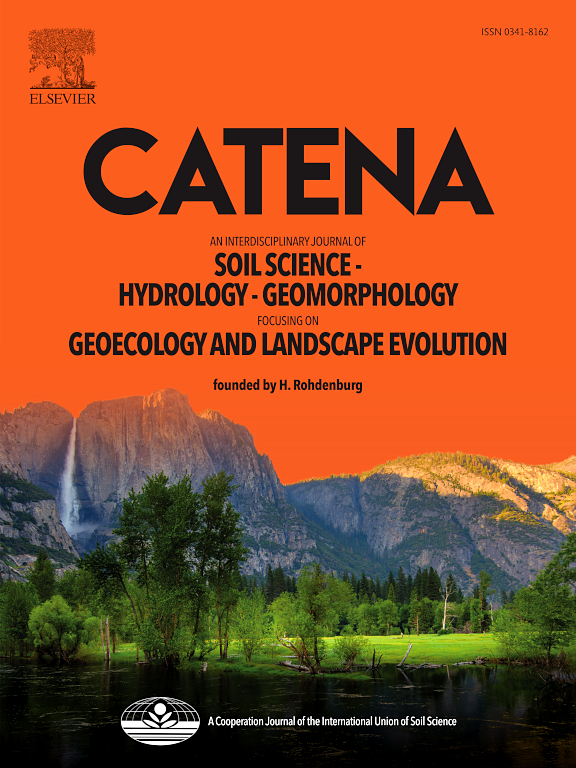IF 5.4
1区 农林科学
Q1 GEOSCIENCES, MULTIDISCIPLINARY
引用次数: 0
摘要
震级较大的地震往往会导致可利用沉积物的变化,而这些可利用沉积物一旦被径流卷入,就会导致灾难性的泥石流事件。地震灾区泥石流事件的有效管理有赖于在集水区尺度上监测可用沉积物的变化,以及在沉积矿床尺度上监测可用沉积物的移动方式。为此,本研究将卫星遥感图像、地面三维激光扫描仪和现场实验相结合,建立了一个跨不同空间尺度的监测框架。这种方法揭示了自 2008 年地震灾害以来,汶川地震灾区典型泥石流集水区切头沟可利用沉积物的演变和迁移模式。因此,我们可以揭示沉积物演化对不同灾害事件的响应,并阐明泥石流灾害前和灾害期间的沉积物迁移模式。研究发现,地震事件导致切头沟内可移动的沉积物增加。对于卷入泥石流的可用沉积物,由于部分松散固结的活性物质源被泥石流带走,因此在泥石流之后,这些沉积物与未卷入泥石流的沉积物相比更加稳定。在泥石流之前和期间,由于地表径流的作用,可用沉积物从海拔较高的上坡迁移到海拔较低的泥石流河道。沉积层底部的局部坍塌以倒退的方式持续发生,主要是由于河道堤岸的横向侵蚀,这与泥石流的规模相辅相成。本文章由计算机程序翻译,如有差异,请以英文原文为准。
Evolution and migration patterns of sediments in an earthquake-affected catchment in Wenchuan, Sichuan Province, China
Earthquakes of magnitude often contribute to changes in sediment availability, and those available sediments, once entrained by runoff, can lead to catastrophic debris flow events. Effective management of debris flow events in seismic areas relies on monitoring the changes in available sediments at the catchment scale and the movement mode of available sediments at the sedimentary deposits scale. For this reason, the present study integrates satellite remote sensing images, terrestrial 3D laser scanner, and field experiments to establish a monitoring framework across diverse spatial scales. This approach reveals the evolution and migration patterns of available sediments in the typical debris flow catchment Cutou gully in the Wenchuan earthquake area since the 2008 earthquake disaster. Accordingly, we can illuminate how sediment evolution responds to different disaster events and clarify the sediment migration patterns before and during debris flow disasters. It is found that the seismic events led to an increase in sediments available for mobilization within Cutou gully. For the available sediments involved in the debris flow, since some of the loosely consolidated active material sources were carried away by the debris flow, following the debris flow, they were more stable compared to those not involved in the debris flow. Available sediments migrated from the upper slopes with higher elevation to the debris flow channel with lower elevation due to surface runoff before and during the debris flow. Localized collapse at the toe of the sedimentary deposits occurred continuously in a retrogressive manner, mainly due to lateral erosion of the channel bank, which complements the magnitude of the debris flow.
求助全文
通过发布文献求助,成功后即可免费获取论文全文。
去求助
来源期刊

Catena
环境科学-地球科学综合
CiteScore
10.50
自引率
9.70%
发文量
816
审稿时长
54 days
期刊介绍:
Catena publishes papers describing original field and laboratory investigations and reviews on geoecology and landscape evolution with emphasis on interdisciplinary aspects of soil science, hydrology and geomorphology. It aims to disseminate new knowledge and foster better understanding of the physical environment, of evolutionary sequences that have resulted in past and current landscapes, and of the natural processes that are likely to determine the fate of our terrestrial environment.
Papers within any one of the above topics are welcome provided they are of sufficiently wide interest and relevance.
 求助内容:
求助内容: 应助结果提醒方式:
应助结果提醒方式:


